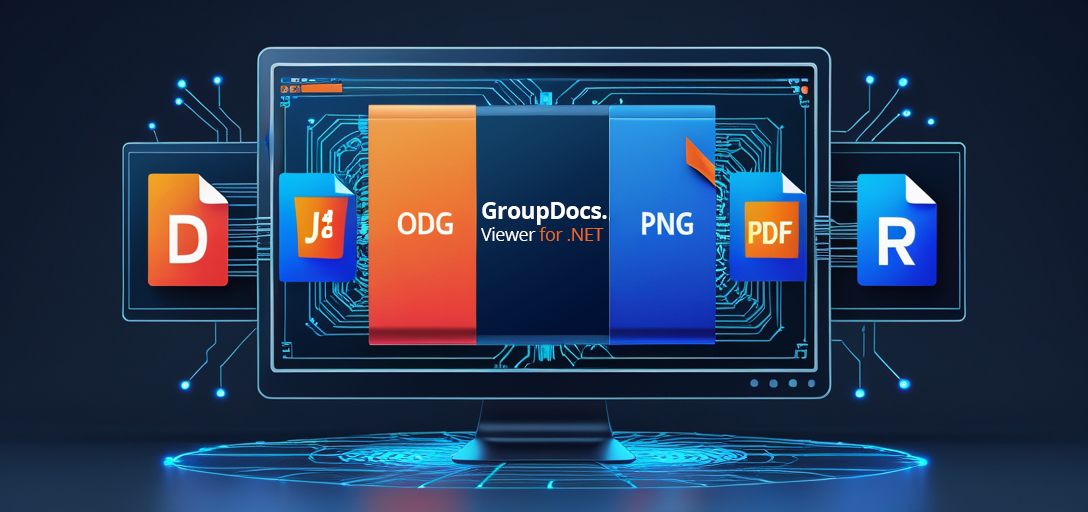Convert FODG/ODG Documents with GroupDocs.Viewer for .NET
Introduction
Are you looking to convert FODG or OpenDocument Graphics (ODG) files into web-friendly formats like HTML, JPG, PNG, and PDF? You’re in the right place! This tutorial guides you through using GroupDocs.Viewer for .NET, a powerful library designed for rendering these document types.

What You’ll Learn:
- Setting up and utilizing GroupDocs.Viewer for .NET
- Step-by-step conversion of FODG/ODG files to various formats
- Performance optimization best practices when using GroupDocs.Viewer
Let’s start with the prerequisites you need before we dive in.
Prerequisites
Before rendering documents with GroupDocs.Viewer for .NET, ensure you have:
Required Libraries and Dependencies
- GroupDocs.Viewer for .NET: Essential for rendering FODG/ODG files. Install via NuGet or .NET CLI.
Environment Setup Requirements
- A development environment with .NET installed (preferably .NET Core 3.1 or later).
- Visual Studio or another C#-supporting IDE.
Knowledge Prerequisites
A basic understanding of C# and document processing concepts is helpful for this tutorial.
Setting Up GroupDocs.Viewer for .NET
To use GroupDocs.Viewer, install the library in your project as follows:
NuGet Package Manager Console
Install-Package GroupDocs.Viewer -Version 25.3.0
.NET CLI
dotnet add package GroupDocs.Viewer --version 25.3.0
License Acquisition
GroupDocs offers a free trial, temporary licenses for evaluation, and full purchase options:
- Free Trial: Download the trial version from GroupDocs.
- Temporary License: Request a temporary license to test without limitations at GroupDocs Temporary License.
- Purchase: For full access, purchase a license directly through the GroupDocs Purchase Page.
Basic Initialization and Setup
Here’s how you can initialize GroupDocs.Viewer in your C# project:
using GroupDocs.Viewer;
// Initialize viewer with the path to an FODG/ODG file
class DocumentConverter {
public void ConvertFodg(string filePath) {
using (Viewer viewer = new Viewer(filePath)) {
// View options will be set up here in subsequent sections.
}
}
}
Implementation Guide
We’ll guide you through each format conversion step by step.
Render FODG/ODG to HTML
Overview
Converting your FODG files to HTML enables easy web display with embedded resources, preserving images and styles.
Step 1: Set Up HTML View Options
using System.IO;
using GroupDocs.Viewer.Options;
class HtmlConverter {
public void ConvertToHtml(string fodgFilePath, string outputDirectory) {
string pageFilePathFormat = Path.Combine(outputDirectory, "fodg_result.html");
using (Viewer viewer = new Viewer(fodgFilePath)) {
HtmlViewOptions options = HtmlViewOptions.ForEmbeddedResources(pageFilePathFormat);
// Render the document to an HTML file with embedded resources
viewer.View(options);
}
}
}
Explanation: HtmlViewOptions.ForEmbeddedResources ensures all elements are self-contained, making HTML files portable.
Troubleshooting Tips:
- Ensure the output directory is writable.
- Verify that your FODG file path is correct and accessible.
Render FODG/ODG to JPG
Overview
Rendering graphics as a JPG is perfect for image previews or web thumbnails.
Step 2: Set Up JPG View Options
using System.IO;
using GroupDocs.Viewer.Options;
class JpgConverter {
public void ConvertToJpg(string fodgFilePath, string outputDirectory) {
string pageFilePathFormat = Path.Combine(outputDirectory, "fodg_result.jpg");
using (Viewer viewer = new Viewer(fodgFilePath)) {
JpgViewOptions options = new JpgViewOptions(pageFilePathFormat);
// Convert the document to a JPG image file
viewer.View(options);
}
}
}
Explanation: JpgViewOptions provides settings for image quality and format.
Render FODG/ODG to PNG
Overview
PNGs are ideal for high-quality images with transparency, useful in many web applications.
Step 3: Set Up PNG View Options
using System.IO;
using GroupDocs.Viewer.Options;
class PngConverter {
public void ConvertToPng(string fodgFilePath, string outputDirectory) {
string pageFilePathFormat = Path.Combine(outputDirectory, "fodg_result.png");
using (Viewer viewer = new Viewer(fodgFilePath)) {
PngViewOptions options = new PngViewOptions(pageFilePathFormat);
// Render the document into a PNG file
viewer.View(options);
}
}
}
Explanation: PngViewOptions allows for high-quality image rendering with optional transparency.
Render FODG/ODG to PDF
Overview
Converting your graphics to PDF provides a universally accessible format, perfect for sharing and printing.
Step 4: Set Up PDF View Options
using System.IO;
using GroupDocs.Viewer.Options;
class PdfConverter {
public void ConvertToPdf(string fodgFilePath, string outputDirectory) {
string pageFilePathFormat = Path.Combine(outputDirectory, "fodg_result.pdf");
using (Viewer viewer = new Viewer(fodgFilePath)) {
PdfViewOptions options = new PdfViewOptions(pageFilePathFormat);
// Render the FODG document into a PDF file
viewer.View(options);
}
}
}
Explanation: PdfViewOptions handles document structure and layout for the PDF output.
Practical Applications
Converting documents with GroupDocs.Viewer can enhance various applications:
- Web Portals: Display graphics in HTML format directly on websites.
- Document Management Systems: Export images as JPG or PNG for previews.
- Reporting Tools: Convert presentations into PDFs for easy sharing and printing.
Integrate GroupDocs.Viewer with other .NET frameworks like ASP.NET Core or Azure Functions to automate document conversion processes seamlessly.
Performance Considerations
To optimize performance when using GroupDocs.Viewer:
- Manage memory efficiently by disposing of viewer instances promptly.
- Use asynchronous operations where possible for large files.
- Adjust quality settings for images (JPG, PNG) based on your needs.
By following these practices, you can ensure smooth and efficient document rendering in your applications.
Conclusion
You’ve now learned how to convert FODG/ODG documents into HTML, JPG, PNG, and PDF using GroupDocs.Viewer for .NET. These skills allow you to enhance the accessibility and usability of graphics within various applications.
Next Steps:
- Explore additional features in the GroupDocs documentation.
- Experiment with different configuration options to tailor outputs to your specific needs.
- Consider integrating these functionalities into larger projects for automated document handling.
Ready to put this knowledge into action? Try implementing GroupDocs.Viewer in your next project and experience seamless document conversion!
FAQ Section
Q1: How do I handle large FODG files with GroupDocs.Viewer? A1: Use asynchronous rendering options and optimize memory usage by disposing of resources promptly.
Q2: Can I customize the output format quality for images?
A2: Yes, adjust settings in JpgViewOptions or PngViewOptions to control image quality.
Q3: Is GroupDocs.Viewer compatible with all versions of .NET? A3: It is compatible with various .NET versions; however, using the latest recommended version ensures optimal performance and compatibility.